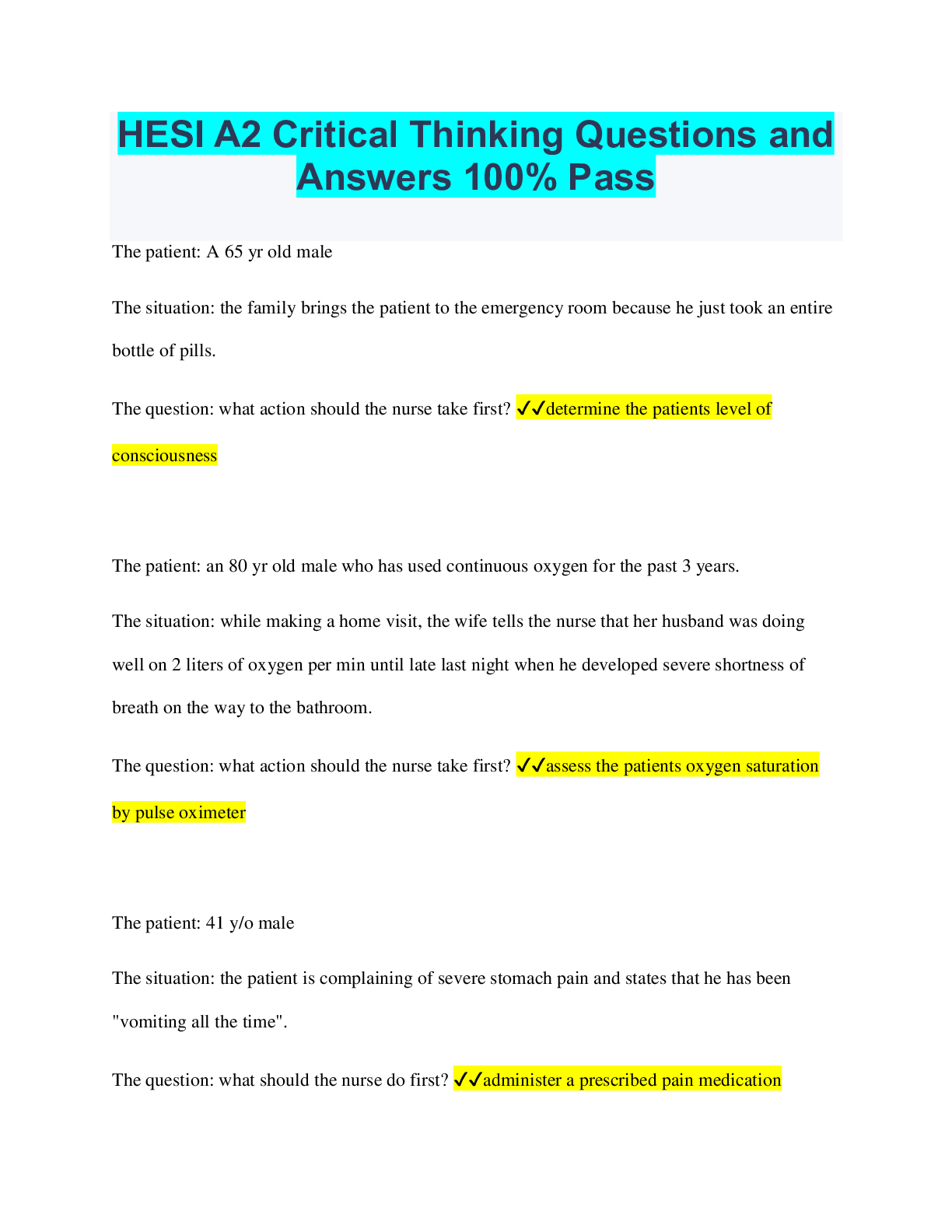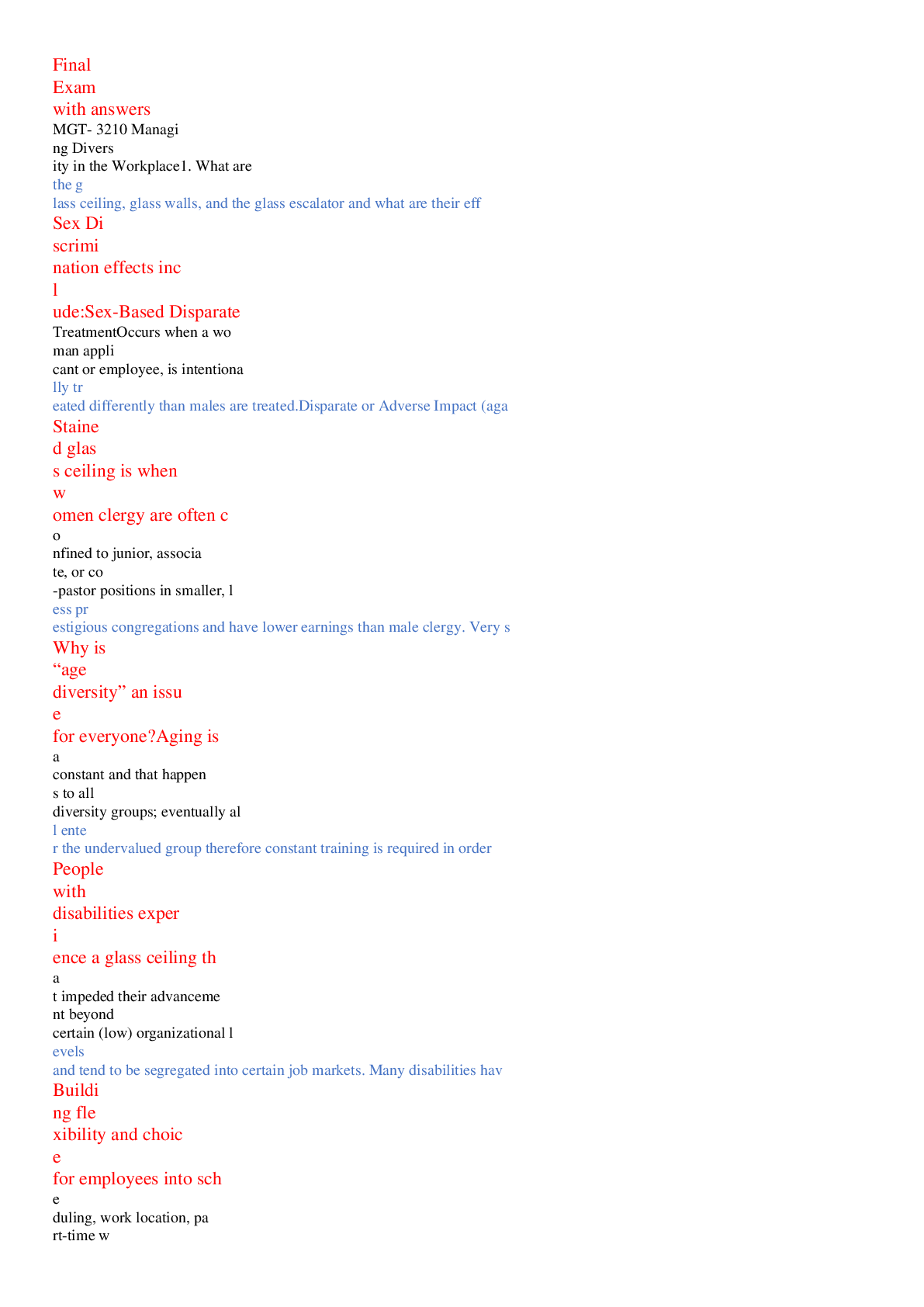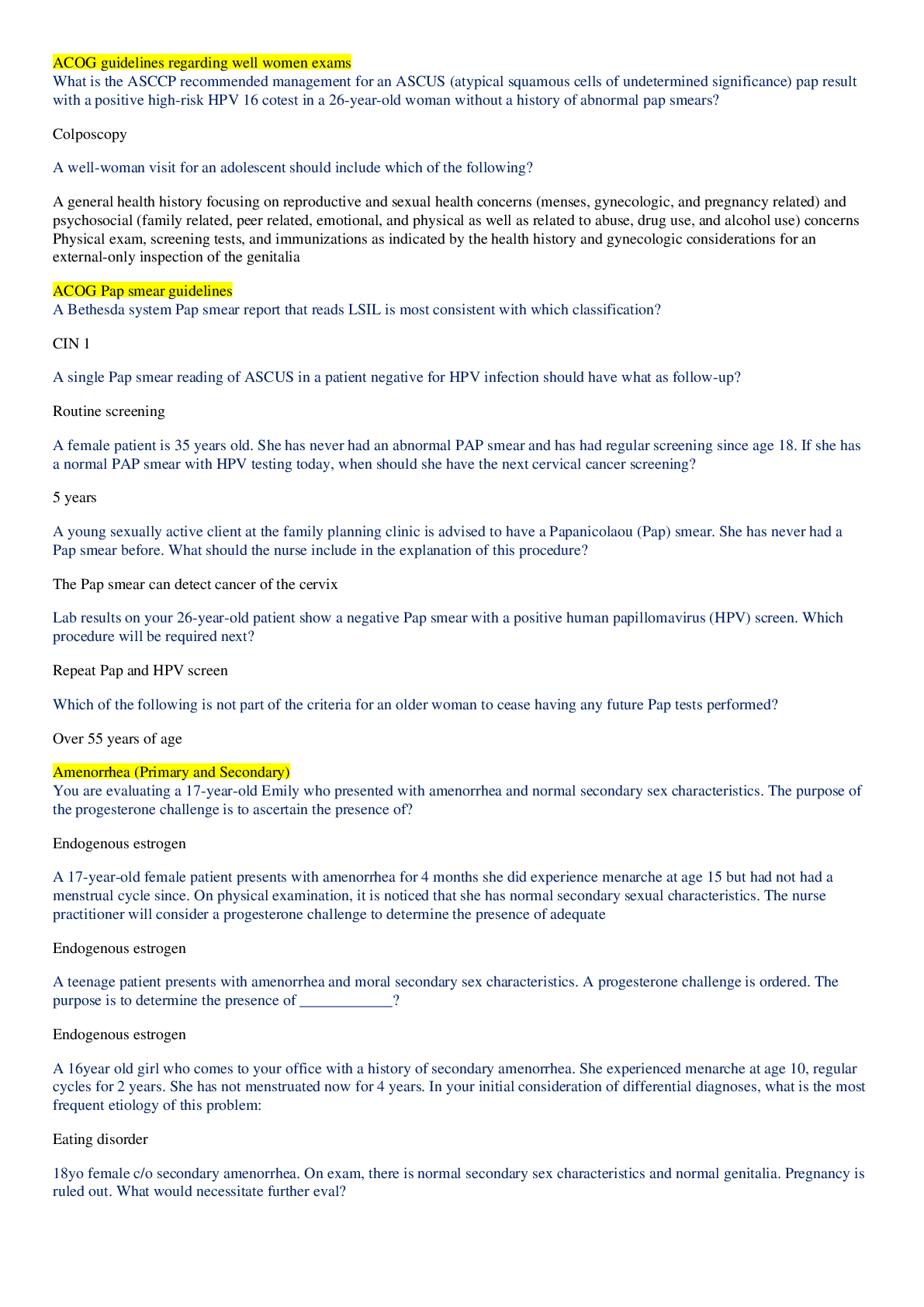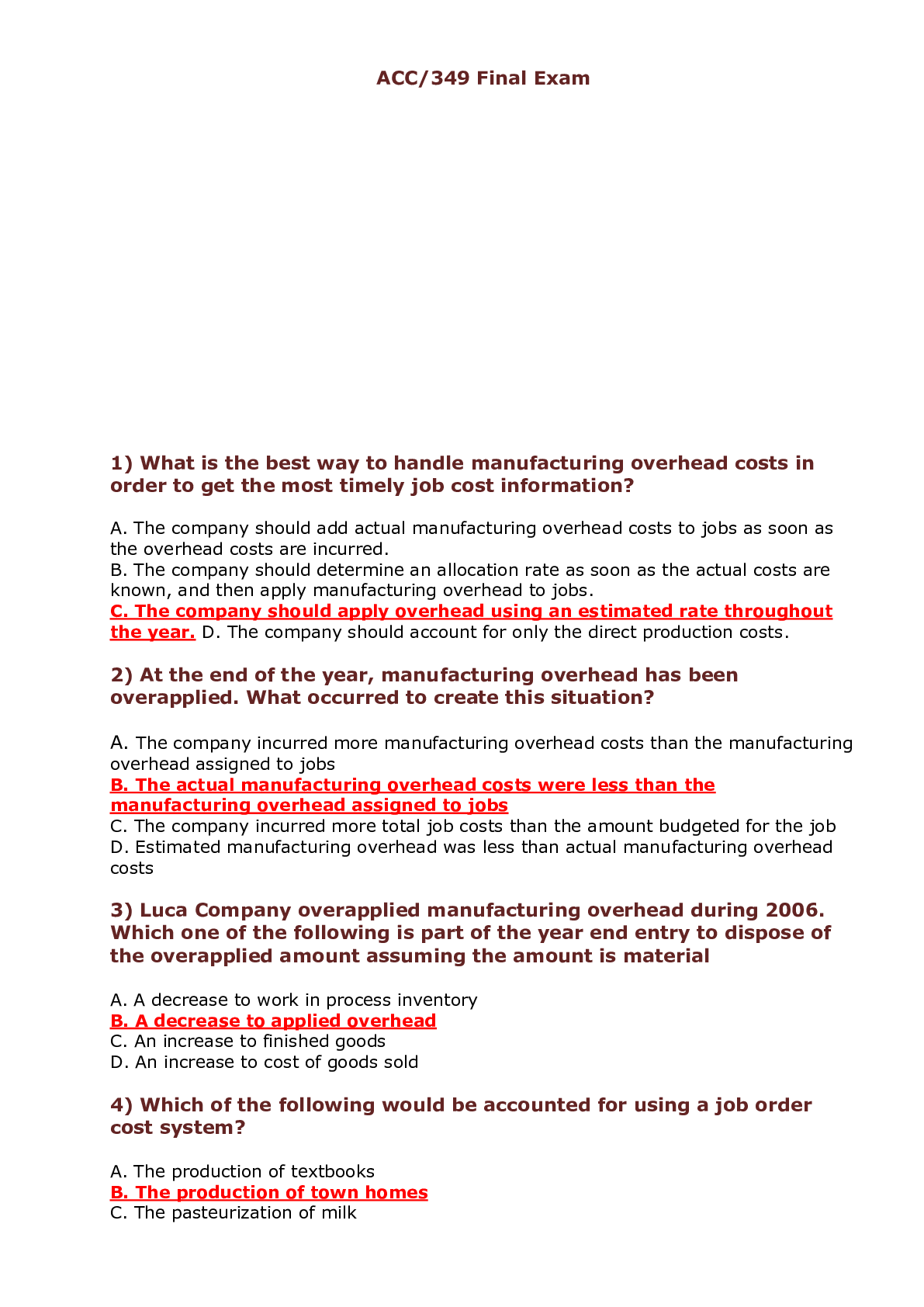Biology > QUESTIONS & ANSWERS > Bio 235 Final Exam With Complete Solution (Latest 2022, already graded A) (All)
Bio 235 Final Exam With Complete Solution (Latest 2022, already graded A)
Document Content and Description Below
Bio 235 Final Exam With Complete Solution (Latest 2022, already graded A) Venous blood returning from systemic circulation first enters the ___, proceeds to the ____, loses ___and gains ____ in the l... ungs, and then returns to the heart via the ____. a) right atrium, right ventricle, pulmonary artery, CO2, O2, pulmonary veins. b) Left atrium, left ventricle, pulmonary artery, CO2, O2, aorta c)Right atrium, right ventricle, pulmonary artery, O2, CO2, pulmonary veins d) Left atrium, right ventricle, pulmonary veins, O2, CO2, aorta Correct Answer- A. Right atrium, right ventricle, pulmonary artery, CO2, O2, pulmonary veins The upper respiratory tract differs from the lower respiratory tract in what way? A) air is taken in through the lower respiratory tract, and CO2/O2 are exchanged in the upper respiratory tract b) air is taken in through the upper respiratory tract, and CO2/O2 are exchanged in the lower respiratory tract c) CO2 is removed from circulation in the upper respiratory tract d) O2 is removed from circulation in the lower respiratory tract Correct Answer- B. Air is taken in through the upper respiratory tract, and CO2/O2 are exchanged in the lower respiratory tract Smooth muscle surrounds which structure of the lower respiratory tract? a) Alveoli b) Alveolar capillaries c) Terminal bronchioles d) Trachea Correct Answer- C. terminal bronchioles In the alveolus, ____squamous epithelial cells are responsible for ___, while ___cells are responsible for ____. a) Type 1; surfactant secretion; Type 2, gas exchange b) type 1; debris removal; type 2; surfactant secretion c) type 3; debris removal; type 1; gas exchange d) type 1; gas exchange; type 2: surfactant secretion Correct Answer- d) type 1; gas exchange; type 2: surfactant secretion There is no net air flow into or out of the lungs when a) P alveolus = P atmostpher b) P alveolus< P atmostphere c) P pleural wall > P atmostphere d) P atmosphere< P pleural wall Correct Answer- a) P alveolus = P atmosphere What keeps the lungs from collapsing Check the Correct Answer- b) trans pulmonary negative pressure caused by negative pressure from pleural cavity Identify the correct sequence of events for inspiration a) diaphragm & inspiratory intercostals relax, lungs expand, air flows into alveoli b) diaphragm & inspiratory intercostals contract; lungs expand, air flows out of the alveoli c) diaphragm & inspiratory intercostals contract, lungs expand, air flows into alveoli d)diaphragm & expiratory intercostals relax, lungs contract, air flows out of alveoli Correct Answer- c) diaphragm & inspiratory intercostals contract, lungs expand, air flows into alveoli the main determiners of lung compliance are a) lung tissue thickness, surface tension of fluid on the inner lung surface b) lung tissue perforations, surface tension of fluid on the inner lung surface c) lung tissue surface area, surface tension of fluid on the inner lung surface d) lung tissue thickness, surface tension of fluid on the outer lung surface Correct Answer- a) lung tissue thickness, surface tension of fluid on the inner lung surface lung compliance is defined as a) lung volume/ transpulmonary pressure b) transpulmonary pressure/ lung volume c) transthoracic pressure/ atmospheric pressure d) none of the above Correct Answer- d) none of the above trained athletes tend to have a) increased lung compliance b) normal lung compliance c) decreased lung compliance d) asthma Correct Answer- a) increased lung compliance which is true abbout the pleural sac a)it is continuous with the atmosphere and protects the lungs from infections b) it is a closed sac surrounding each lung and contains only a tiny volume of lubricating fluid c) it is a closed sac surrounding each lung and contain a large volume of surfactact d) it is a closed, air-filled space surrounding both lungs that has a negative pressure compared to atmospheric pressure Correct Answer- b) it is a closed sac surrounding each lung and contains only a tiny volume of lubricating fluid which structure is NOT part of the "anatomical dead space?" a) bronchiole b) trachea c) bronchus d)respiratory bronchiole Correct Answer- d)respiratory bronchiole the volume of air flowing into the alveoli during inhalation/inspiration is increased when there is an increase in which of these? a)air resistance b)the pressure gradiant from the atmosphere to the alveoli c) the pressure in the intrapleural space d) the curvature of the diaphragm Correct Answer- b)the pressure gradiant from the atmosphere to the alveoli under normal circumstances, which of the following would result from an increase in transpulmonary pressure? a) inhalation/inspiration b) exhalation/expiration c) a collapsed lung d) emphysema Correct Answer- a) inhalation/inspiration which of the following statements about the response of arteriole smooth muscle to changing ocygen partial pressure is true? a) both systemic and pulmonary arterioles respond to a decrease in PO2 by constricting b) both systemic and pulmonary arterioles respond to a decrease in PO2 by dilating c) systemic arterioles respond to a decrease in PO2 by dilating but pulmonary arterioles constrict in response to decreased PO d) systemic arterioles respond to a decrease in PO2 by constricting but pulmonary arterioles dilate in response to decreased PO2 Correct Answer- c) systemic arterioles respond to a decrease in PO2 by dilating but pulmonary arterioles constrict in response to decreased PO [Show More]
Last updated: 2 years ago
Preview 1 out of 41 pages

Buy this document to get the full access instantly
Instant Download Access after purchase
Buy NowInstant download
We Accept:

Reviews( 0 )
$10.00
Can't find what you want? Try our AI powered Search
Document information
Connected school, study & course
About the document
Uploaded On
May 17, 2022
Number of pages
41
Written in
Additional information
This document has been written for:
Uploaded
May 17, 2022
Downloads
0
Views
97
















.png)



.png)
.png)
 answer.png)



